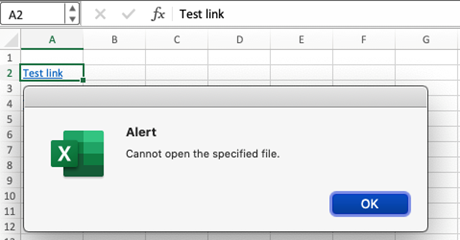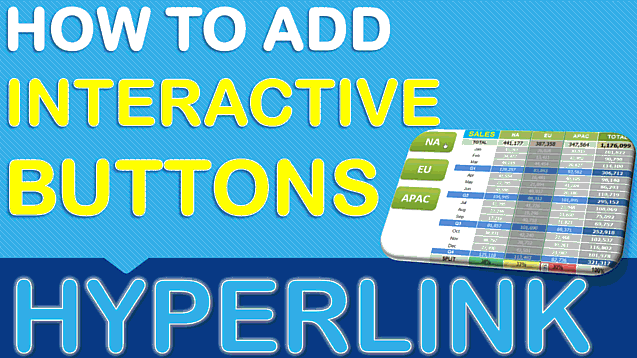-->
Note
Dear All The following code works fine on Windows 8/Excel 2007, but will not work on Mac computer I am struggling to find a solution The code takes the postcode elements from columns 30-31 of the selected row appends them to the URL and navigates to address Thanks in advance Simon Public.
Hi - I'm preparing an Excel spreadsheet that has a detailed travel itinerary, and want to include hyperlinks to web pages of interest. There's no problem copying and pasting the full web address (via Command-C and Command-V) into the Hyperlink dialog, and the web address turns blue, is underlined, and looks fine - but when you click on it. In the Excel desktop application, to select a cell that contains a hyperlink without jumping to the hyperlink destination, click the cell and hold the mouse button until the pointer becomes a cross, then release the mouse button. In Excel for the web, select a cell by clicking it when the pointer is an arrow; jump to the hyperlink destination by clicking when the pointer is a pointing hand. The HYPERLINK function creates a shortcut that jumps to another location in the current workbook, or opens a document stored on a network server, an intranet, or the Internet. When you click a cell that contains a HYPERLINK function, Excel jumps to the location listed, or opens the document you specified.
Office 365 ProPlus is being renamed to Microsoft 365 Apps for enterprise. For more information about this change, read this blog post.
Introduction
This step-by-step article describes how to enable or to disable the display of a warning message every time that you click a hyperlink in a Microsoft Office program.
More Information
Important
This section, method, or task contains steps that tell you how to modify the registry. However, serious problems might occur if you modify the registry incorrectly. Therefore, make sure that you follow these steps carefully. For added protection, back up the registry before you modify it. Then, you can restore the registry if a problem occurs. For more information about how to back up and restore the registry, see How to back up and restore the registry in Windows.
In Microsoft Office applications, when you click a hyperlink or an object that links to an executable file, you receive the following warning message:

This behavior occurs regardless of your security level settings.
Note
To locate your security level settings, point to Macro on the Tools menu, and then click Security.
Additionally, when you open either TIFF images or Microsoft Document Imaging (MDI) files, you receive the following warning message:
You receive this warning message even when you have already implemented the registry key that this article describes. This warning message comes from the HLINK.dll file when link navigation is handled. You can differentiate the Microsoft Office hyperlink warning message from the HLINK warning message by looking for quotation marks around the file path in the warning message. The Microsoft Office message contains quotation marks. The HLINK message does not contain quotation marks. Microsoft Office tries to determine whether the file type itself is unsafe by checking the extension, the progid, the classid, and the MIME type of the document.
How to globally enable or disable hyperlink warnings
To enable or to disable the hyperlink warnings in Microsoft Office programs when an https:// address, a notes:// address, or an ftp:// address is used, you must create a new registry subkey. To do this, follow these steps:
Mac Excel Break Links Not Working
Click Start, and then click Run.
In the Open dialog box, type regedit, and then click OK.
Note
- You have to modify only one of these registry subkeys. You do not have to modify both.
- If the Security subkey already exists, go directly to step 6 after you select the Security subkey.
Locate and then select the following registry subkey (if the subkey does not exist, create it manually):HKEY_CURRENT_USERSoftwareMicrosoftOfficexx.0Common
Note In this subkey, replace 'xx.0' with 12.0 for Office 2007, 14.0 for Office 2010, 15.0 for Office 2013, and 16.0 for Office 2016 and later.
Click the registry subkey, point to New on the Edit menu, and then click Key.
Type Security, and then press Enter to name the key.
On the Edit menu, point to New, and then click DWORD Value.
Type DisableHyperlinkWarning, and then press Enter to name the entry.
In the right pane, right-click DisableHyperlinkWarning, and then click Modify.
In the Edit DWORD Value dialog box, click Decimal, and then type 1 or 0 under Value data.
Note
A value of 0 enables the hyperlink warning message. A value of 1 disables the hyperlink warning message.
Click OK.
Exit Registry Editor.
How to enable or disable hyperlink warnings per protocol
To disable the display of security warnings for a specific protocol, follow these steps:
Click Start, click Run, type regedit, and then click OK.
Locate the following registry subkey:
HKEY_CURRENT_USERSoftwarePoliciesMicrosoftOfficexx.0CommonSecurityTrusted ProtocolsAll Applications
Note In this subkey, replace 'xx.0' with 12.0 for Office 2007, 14.0 for Office 2010, 15.0 for Office 2013, and 16.0 for Office 2016 and later.
Click the All Applications subkey.
On the Edit menu, point to New, and then click Key.
Type the name of the protocol that you want to exclude. For example, to disable the display of a security warning for the 'Notes:' protocol, type Notes:.
Note Make sure that you include the colon (:) character.
Press Enter.
Exit Registry Editor.
Excel Cannot Open Specified File Hyperlink
If you still receive a warning message
After you disable warning messages, you may still receive a warning message from Microsoft Windows. If you continue to receive a warning message after you follow the steps in this article, use one of the following methods to resolve the issue.
Note
Method 1 applies only to Windows XP and to earlier versions of Windows. For Windows Vista and for later versions of Windows, use method 2.
Method 1: Turn off the 'Confirm open after download' option for the file type that you are trying to open
- Double-click My Computer.
- On the Tools menu, click Folder Options.
- On the File Types tab, select the appropriate file name extension (for example, WMV) in the Registered File Types box, and then click Advanced.
- Click to clear the Confirm open after download check box, and then click OK.
- In the Folder Options dialog box, click Close.
Method 2: Modify the HKEY_CLASSES_ROOT<CLSID>EditFlags registry subkey
Use this method if the warning message affects multiple computers.
To disable the warning message, follow these steps:
Click Start, click Run, type regedit, and then click OK.
Locate the following registry subkey:
HKEY_CLASSES_ROOT<CLSID>EditFlags
For example, if the file name extension is WMV, select HKEY_CLASSES_ROOTWMVFileEditFlags
Click EditFlags, and then click Rename on the Edit menu.
Type OldEditFlags, and then press ENTER.
On the Edit menu, point to New, and then click DWORD value.
Type EditFlags, and then press ENTER.
On the Edit menu, click Modify.
In the Edit DWORD Value dialog box, click Hexadecimal under Base.
Type 10000, and then click OK.
To re-enable the warning message, follow these steps:
Click Start, click Run, type regedit, and then click OK.
Locate the following registry subkey:
HKEY_CLASSES_ROOT<CLSID>EditFlags
Click EditFlags, and then click Modify on the Edit menu.
Type 0, and then click OK.
Note
Even after you follow these steps, you will receive the warning message if you open files under Protected View.
Did this fix the problem?

Check whether the problem is fixed. If the problem is fixed, you are finished with this section. If the problem is not fixed, you can contact support.
-->Note
Office 365 ProPlus is being renamed to Microsoft 365 Apps for enterprise. For more information about this change, read this blog post.
If you have Skype installed, see Text has incorrect format when using paste in Microsoft Office for more information. The Paste Special option can make the task of pasting text go more smoothly by letting you choose which formatting you want to keep (source or destination) or by stripping all the formatting and just pasting the text. If you are having issues with the Paste Special option, continue on to the resolutions below.
Resolution
To see if the Paste Special option is enabled:
Links Not Working In Excel
- Go to File > Options > Advanced.
- Under Cut, copy and paste, ensure the Show Paste Options button when content is pasted option is checked.
Mac Excel Hyperlink Not Working Windows 10
Note
Using the Worksheet_SelectionChange event will clear the clipboard, which disables the Paste Special option. To enable the option, you need to set the value of the Application.EnableEvents property to False.
Ensure that all instances of the web browsers that you use are closed and try to use the Paste Special option again. Paste special will not function if your web browser is causing the conflict. Windows Internet Explorer (8-9) do not conflict with the Paste Special option in Excel 2010. Third party Add-ins can cause a variety of issues, one of then being, conflicting with the Paste Special option. To determine if an add-in is causing the issue:
Find the Microsoft Excel icon.
Press and hold the CTRL key and double-click the application shortcut.
Click Yes when a window appears asking if you want to start the application in Safe Mode.
Note
If you have an icon on your desktop, hold the CTRL key and click on the icon. This works with any Microsoft Office product.
If the Paste Special option works in the Safe Mode as follows, enable your Add-ins one by one until you hit that one that is causing the conflict. Leave that one disabled or uninstall it.
Note
For more information, see Adding or Removing Add-ins and Working with Office Safe Modes..
|
You can also get help from the Microsoft Community online community, search for more information on Microsoft Support or Windows Help and How To, or learn more about Assisted Support options.



